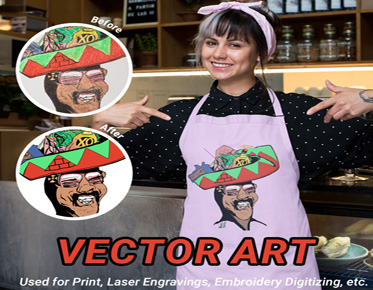How can you tailor Embroidery Digitizing Services for customization and personalization?
Embroidery digitizing has evolved from a traditional craft to a sophisticated art form, blending craftsmanship with technology. In this article, we explore the world of customization and personalization within embroidery digitizing services. From understanding the basics to overcoming challenges, we delve into how businesses can tailor their services to meet individual preferences and enhance brand identity.
Embroidery digitizing involves translating intricate designs into digital formats compatible with embroidery machines. The process encompasses a myriad of techniques, from selecting appropriate stitch types to optimizing design elements for different materials. Technology plays a crucial role in this field, offering advanced software tools that streamline the digitization process and enhance precision.
Basics
of Embroidery Digitizing
At its core, embroidery digitizing requires a deep understanding of stitching techniques, fabric properties, and design principles. Each stitch type and direction contributes to the overall appearance and durability of the embroidered design. Moreover, factors such as thread tension and density must be carefully calibrated to achieve optimal results.
Role of
Technology in Embroidery Digitizing
Advancements in technology have revolutionized embroidery digitizing, making it more accessible and efficient. Digitizing software offers a range of features, from automated stitch generation to color matching algorithms, that simplify the digitization process. Additionally, computerized embroidery machines enable precise stitching and consistent results, even on complex designs.
Customization and personalization are essential aspects of modern consumerism, allowing businesses to cater to individual preferences and enhance brand loyalty. In the realm of embroidery digitizing, customization involves creating unique designs that resonate with customers, while personalization adds a personal touch that fosters deeper connections.
Meeting
Individual Preferences
Every customer is unique, with distinct preferences and tastes. By offering customization options, businesses can tailor their embroidery digitizing services to meet the specific needs of each client. Whether it's a custom-designed logo or a personalized monogram, customized embroidery adds a personal touch that sets businesses apart from their competitors.
Enhancing
Brand Identity
Embroidery digitizing offers businesses a powerful tool for reinforcing their brand identity. By incorporating brand elements such as logos, colors, and slogans into embroidered designs, businesses can enhance brand visibility and recognition. Custom-designed embroidery serves as a tangible representation of the brand, leaving a lasting impression on customers and stakeholders.
Increasing
Customer Engagement
Personalized embroidery fosters meaningful interactions between businesses and their customers. By involving customers in the design process and incorporating their feedback, businesses can create products that resonate on a personal level. This interactive approach not only strengthens customer relationships but also fosters a sense of ownership and pride among customers.
Custom Design Creation
Crafting custom designs is a collaborative process that requires close communication between the client and the service provider. By understanding the client's vision and incorporating their input, designers can create bespoke designs that reflect the client's personality and align with their brand identity. This collaborative approach ensures that the final product exceeds the client's expectations.
Collaborative
Process
Effective customization begins with open communication and collaboration. By involving clients in the design process from the outset, designers can ensure that their designs accurately reflect the client's vision. Regular feedback and iterations allow for adjustments to be made along the way, resulting in a final product that meets the client's specifications.
Incorporating
Client's Vision
Translating the client's vision into a tangible design requires creativity and intuition. Designers must not only understand the client's aesthetic preferences but also anticipate their needs and desires. By actively involving clients in the design process and soliciting their feedback, designers can ensure that the final product accurately reflects the client's vision and exceeds their expectations.
Personalized Placement and Sizing
Embroidery placement and sizing play a crucial role in the overall appearance and functionality of embroidered designs. Different materials and garments require different approaches to achieve optimal results. By adapting to the unique characteristics of each material and garment, designers can ensure that the embroidery complements the overall aesthetic and enhances the wearer's experience.
Adaptation
to Different Materials
Embroidery digitizing involves working with a wide range of materials, each with its own unique properties and challenges. From delicate fabrics to sturdy textiles, designers must adapt their techniques to achieve optimal results. By understanding the characteristics of each material and employing appropriate techniques and tools, designers can ensure that the embroidery is both visually appealing and structurally sound.
Ensuring
Aesthetic Appeal
Ultimately, the success of embroidery digitizing hinges on its aesthetic appeal. Whether it's a subtle logo on a corporate uniform or an elaborate design on a fashion garment, the embroidery must enhance the overall aesthetic and convey the desired message. By paying attention to factors such as color, texture, and placement, designers can create designs that captivate the viewer's attention and leave a lasting impression.
Color Customization
Color is a powerful tool in embroidery digitizing, capable of evoking emotions and conveying brand messages. Matching brand colors is essential for maintaining brand consistency and recognition. Additionally, catering to customer preferences allows businesses to offer personalized experiences that resonate with their target audience.
Matching
Brand Colors
Consistency is key when it comes to branding, and color plays a crucial role in maintaining brand identity. By accurately matching brand colors in embroidered designs, businesses can reinforce their brand image and enhance brand recognition. Whether it's a specific Pantone shade or a custom color palette, designers must ensure that the embroidery accurately reflects the brand's visual identity.
Catering
to Customer Preferences
In addition to brand colors, customers may have their own preferences when it comes to color. By offering a wide range of color options and accommodating custom requests, businesses can cater to the diverse tastes and preferences of their customers. Whether it's a bold statement or a subtle accent, color customization allows customers to express their individuality and make their mark.
In a competitive market, customization and personalization offer businesses a distinct competitive advantage. By offering unique and personalized products, businesses can differentiate themselves from their competitors and attract a loyal customer base. Moreover, customization fosters creativity and innovation, allowing businesses to stay ahead of trends and meet evolving consumer demands.
Differentiation
in a Competitive Market
Standing out from the crowd is essential for success in a competitive market. Customization allows businesses to offer unique products that cannot be replicated by their competitors. Whether it's a custom-designed logo or a personalized monogram, custom embroidery sets businesses apart and captures the attention of customers.
Building
Customer Loyalty
Personalization fosters a deeper emotional connection between businesses and their customers. By involving customers in the design process and offering personalized products, businesses can create memorable experiences that resonate on a personal level. This emotional bond fosters loyalty and advocacy, turning customers into brand ambassadors who actively promote and support the business.
Flexibility
in Design Options
One of the key advantages of embroidery digitizing is its versatility. Unlike traditional methods of embroidery, which are limited by manual labor and time constraints, digital embroidery offers virtually limitless design options. By harnessing the power of technology, businesses can create intricate designs with unparalleled precision and detail.
Despite its numerous benefits, customization, and personalization in embroidery digitizing come with their fair share of challenges. Complex design requests can lead to miscommunication and frustration, while technical constraints such as limited thread colors or stitching techniques can pose obstacles. However, by employing effective communication strategies and leveraging advanced software tools, businesses can overcome these challenges and deliver high-quality results that exceed customer expectations.
Complexity of Design Requests
One of the primary challenges in embroidery digitizing is the complexity of design requests. Customers may have specific ideas and requirements that can be difficult to translate into digital format. This can lead to misunderstandings and delays if not addressed effectively.
Streamlining
Communication
Effective communication is essential for successful customization and personalization. By maintaining open lines of communication with customers throughout the design process, businesses can ensure that all parties are on the same page and that any issues or concerns are addressed promptly.
Providing
Visual References
Visual references play a crucial role in the customization process. By providing customers with mock-ups or samples of their designs, businesses can give them a tangible idea of what to expect and solicit their feedback. This not only helps to clarify design requirements but also ensures that customers are satisfied with the final product.
Technical Constraints
Technical constraints such as limited thread colors or stitching techniques can pose challenges in embroidery digitizing. Customers may have specific color requirements or intricate design elements that are difficult to replicate using standard techniques. However, by utilizing advanced software tools and offering expert consultation, businesses can overcome these obstacles and deliver high-quality results that exceed customer expectations.
Utilizing
Advanced Software Tools
Technology has revolutionized the field of embroidery digitizing, providing designers with advanced software tools that streamline the digitization process and enhance precision. From digitizing software to machine embroidery software, these tools offer a wide range of features and capabilities that enable designers to create complex designs with ease.
Offering
Expert Consultation
In addition to software tools, businesses can also benefit from expert consultation in embroidery digitizing. Experienced digitizers can offer valuable insights and recommendations based on their knowledge and expertise. Whether it's selecting the right materials or optimizing design elements for embroidery, expert consultation can help businesses overcome technical challenges and achieve their desired outcomes.
Understanding
Target Audience
Effective customization and personalization begin with a deep understanding of the target audience. By identifying their preferences, tastes, and needs, businesses can tailor their offerings to meet their specific requirements.
Investing
in Quality Materials
The quality of materials used in embroidery digitizing can significantly impact the final outcome. From thread and fabric to backing materials and stabilizers, every component plays a crucial role in the success of the embroidery.
Keeping
Up with Trends
In a fast-paced industry like embroidery digitizing, staying ahead of trends is essential for success. By keeping abreast of the latest design trends, techniques, and technologies, businesses can ensure that their offerings remain relevant and competitive.
In conclusion, customization and personalization are integral aspects of modern embroidery digitizing services. By tailoring their offerings to meet individual preferences, businesses can forge deeper connections with their customers and establish themselves as leaders in the industry. As technology continues to evolve and consumer expectations evolve, the importance of customizationand personalization in embroidery digitizing will only continue to grow, shaping the future of the industry for years to come.
Ready to explore the endless possibilities of
customization and personalization in embroidery digitizing? Contact Eagle
Digitizing today to discover how our team of professionals can bring
your vision to life with precision, quality, and expertise. Whether you're a
business looking to enhance your brand identity or an individual seeking
personalized embroidery solutions, Eagle Digitizing has you covered.



